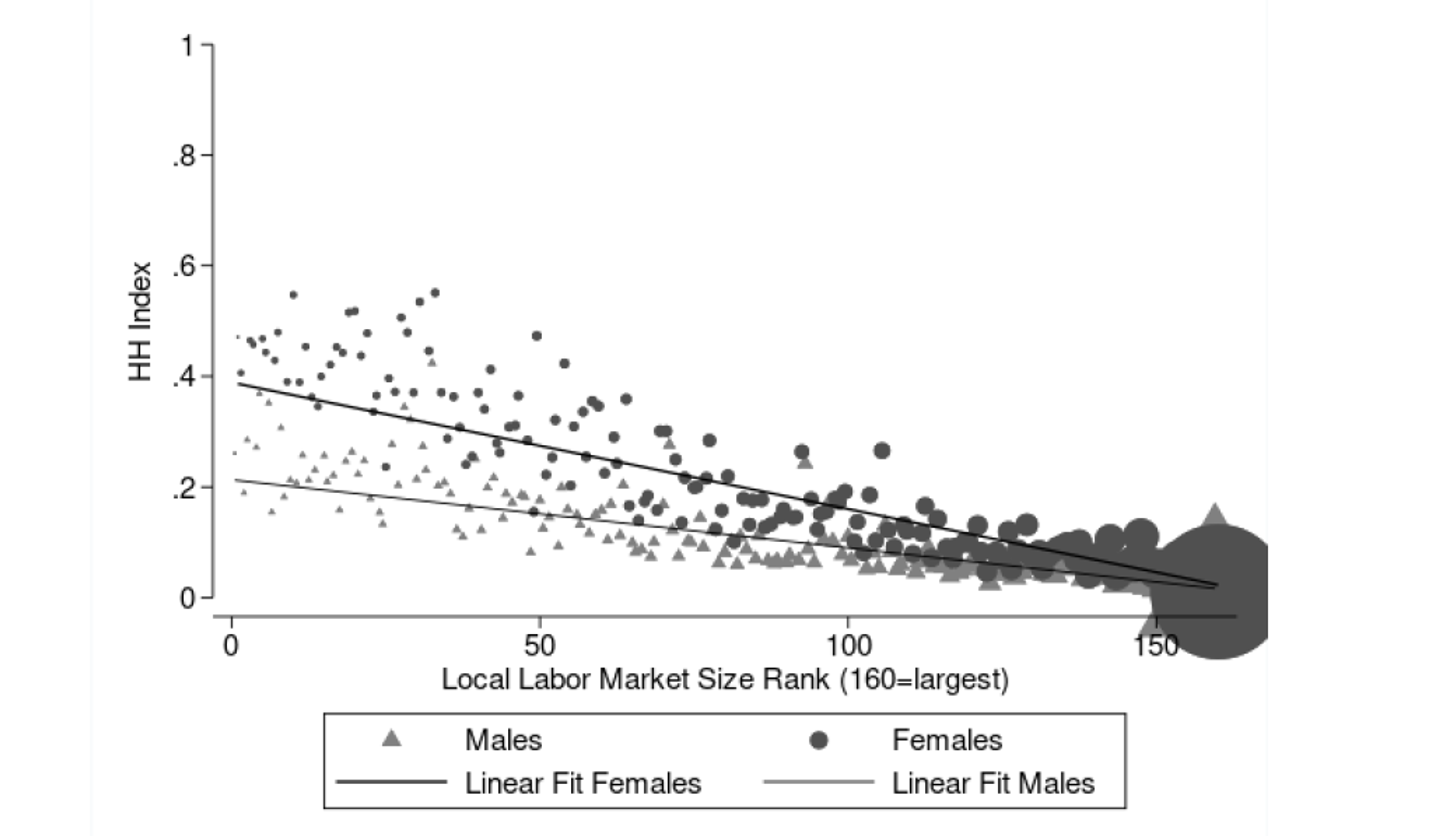The extent to which employers exercise wage-setting power in labour markets (also known as monopsony power) is a core empirical question that has wide-ranging implications for workers, firms, and labour market regulation. This is because firms with monopsony power can set both wages and employment below the levels that would prevail if the market was perfectly competitive. The extent and scope of monopsony power across labour markets thus has implications for the distribution of earnings and inequality. For example, monopsony power in certain occupations is one explanation for the findings that minimum wages do not reduce employment, and the fact that men and women sort into occupations characterised by different degrees of concentration is one explanation for why the gender wage gap may be so persistent. Because monopsony power has such wide-ranging implications for workers, government regulators often consider how mergers and acquisitions will impact the market power of the affected firm. Mischaracterising the extent of monopsony power from a merger or acquisition could lead an otherwise efficiency-enhancing merger not to occur, or it could lead to a merger that harms workers. Correctly measuring the extent of firm market power therefore has critically important implications for firms, workers, and the aggregate economy.
Task-based approach to measure concentration
Economists have used several different approaches to measure employer market power that typically rely on economic models of labour markets. Typically, these methods force researchers to focus on one occupation, such as teachers or nurses, and do not allow one to examine monopsony power more broadly.
Recently, a large body of work has emerged that uses a more direct measure of employer market power: the concentration of workers across employers. Labour markets are concentrated if workers of a given type are concentrated in a small number of firms in a local labour market. The canonical example of a monopsonist is a single mining company in a small town, where all mining workers are concentrated in a single firm. Researchers measure this concentration by calculating the Hirschman-Herfindahl Index (HHI), which is the squared share of employment of workers of a given type across firms in a local labour market.
A central challenge in measuring labour market concentration is how to categorise workers into similar ’types’. Existing research has characterised workers using occupation or industry, where concentration is based on the share of a local labour market in each occupation or industry employed by particular firms (e.g. Azar et al. 2020a, 2020b, Azar et al. 2019, Benmelech et al. 2018, Marinescu et al. 2019, Qiu and Sojourner 2019, Rinz 2018).
The drawback of such approaches is that workers can move across occupations or industries, especially if there are jobs in the economy that require similar skills. That is, job tasks are substitutable across occupations and industries. For example, an administrative assistant in one industry can perform that job in another industry. His task-related skills also can translate to other occupations, such as a bookkeeper. Put simply, a main challenge in measuring monopsony power is grouping occupations together in a way that captures the concentration in the demand for job tasks across firms in the labour market. In our recent paper, we extend the literature on monopsony and labour market concentration by taking a task-based approach to estimate the causal effect of monopsony power on labour market outcomes (Dodini et al. 2022). We argue that the concentration of demand for specific job tasks is a more relevant measure of labour market concentration than has been used in prior work because it allows for the substitutability of workers across closely related industries and occupations.
Task-based measure of labour market concentration
Using rich Norwegian register data with links between individual workers, occupations, and firms that are not available in the US, we estimate a direct, task-based measure of workers’ outside options (i.e. other jobs in their local economy that require a similar set of tasks). We do this by combining the register data with information on the task content of occupations from O*NET. We then employ an unsupervised machine learning technique and let the data inform us how to group workers together based on the task content of their current job. This allows us to group workers together based on task-based skills without having to impose any strong assumptions about the relationship between occupations, industries, and local employment.
Panel A of Figure 1 shows that there is substantial variation in task-based skill demand concentration across and within labour markets in Norway. We compare a common metric of concentration (HHI) using task-based clusters, occupations (Panel B), industries (Panel C), and education (Panel D). The results show that, especially for small and medium-sized labour markets, our task-based measure exhibits lower levels of concentration. This is important because the task-based measure allows for substitution across industries and occupations with similar task requirements in a way that the industry- and occupation-based measures do not. This has important policy implications if regulatory bodies are using occupation or industry measures to assess the implications of a merger or acquisition.
Figure 1 Herfindahl-Hirschman Indices by local labour market
Our data allow us to examine differences by gender as well. Figure 2 shows that women tend to be in task-based skill groups that are much more concentrated than men. This difference can be explained by differential sorting of men and women into the public versus private sector. Women are much more likely to be in the public sector, which exhibits a higher level of concentration. Within sector, the gender differences are small.
Figure 2 Skill-based Herfindahl-Hirschman Indices by local labour market and gender
The causal effect of labour market concentration
After having generated our task-based concentration measure and compared it to conventional occupation- and industry-based measures, we use our new measure to study the causal effect of labour market concentration on workers. The thought experiment underlying our approach is to consider workers who are involuntarily separated from their jobs in labour markets that differ in terms of their level of concentration. These workers then need to search for new jobs in differently concentrated markets. The wage offers they receive will be determined by the set of outside options they have, which is shaped by concentration. Their sensitivity to wage offers is determined by the slope of the labour supply curve in their local labour market. A concentrated market is associated with a steeper curve, which leads to a lower wage after they are laid off from their current job. We approximate this thought experiment by inducing job search through mass layoffs and firm closures among individuals who are observationally similar but who are in markets that are differentially concentrated.
The results from our empirical analysis show that workers facing similar displacement events have worse subsequent labour market outcomes when they are in more concentrated task clusters. A worker with a 0.10 higher HHI (about one standard deviation in our data) who experiences a mass layoff or an establishment closure has annual earnings that are 9,120 NOK lower after the event, which is 1.78% relative to the mean. We find positive but not statistically or economically significant effects on being out of the labour force and on employment, suggesting that the wage effects are driven predominantly by the wages people get when they are rehired rather than whether or not they get a job at all. Consistent with the importance of the wage response, an increase in HHI of 0.1 point leads to a one percentage point increase in the likelihood of working part time after separation. In addition, our results point to reduced skill upgrading and increased skill downgrading in higher HHI clusters after separation. This means that those in more concentrated labour markets are more likely to be working in jobs with a lower average amount of education attainment compared to the job from which they were laid off.
We also estimate our model separately for men and women. The results show that the effect of monopsony power on post-separation earnings is larger for men than for women: male wages decline by 11,890 NOK (or 2.04%), while female wages are reduced by 4,812 NOK (1.13%). This difference is driven almost entirely by differential effects of concentration in the public and private sector. The effect on earnings for men and women are large in the private sector and are more modest in the public sector. Women are more likely to work in the public sector, which exposes them to higher concentration but mitigates the effect of concentration on labour market outcomes.
Policy relevance and concluding remarks
We broaden our understanding monopsony and labour market concentration by taking a task-based approach to estimate the causal effect of monopsony power on labour market outcomes. Our methodological contribution and empirical results have important policy implications, since a precise measurement of monopsony power is imperative for proper regulation of the labour market. Proposals to the US Congress support giving the Department of Justice the power to regulate the effects of prospective mergers and acquisitions on labour market concentration, similar to the way product market concentration is currently being examined. An essential part of those proposals is the use of labour market concentration measures that are calculated within an occupation or industry. These measures may overstate effective market concentration by omitting workers’ outside options. Without adjusting relevant regulatory thresholds, regulators may impose too strong limitations on firm actions that might otherwise pose no threat to labour market competition or may prevent mergers that might otherwise lead to earnings growth for workers and owners. At the same time, our results demonstrate that labour market concentration poses real risks to workers’ wellbeing that should be considered by regulatory bodies.
References
Azar, J, I Marinescu and M Steinbaum (2020a), “Labor Market Concentration.” Journal of Human Resources 1218–9914R1.
Azar, J, I Marinescu, M Steinbaum and B Taska (2020b), “Concentration in US labor Markets: Evidence from Online Vacancy Data”, Labour Economics 66.
Azar, J, S Berry and I E Marinescu (2019), “Estimating Labor Market Power”, Available at SSRN 3456277.
Benmelech, E, N Bergman and H Kim (2018), “Strong Employers and Weak Employees: How Does Employer Concentration Affect Wages?”, Technical report, National Bureau of Economic Research.
Dodini, S, M Lovenheim, K Salvanes and A Willen (2022), “Monopsony, Job Tasks, and Labor Market Concentration”, NBER Working Paper No. 30823
Marinescu, I E, I Ouss and L-D Pape (2019), “Wages, Hires, and Labor Market Concentration”, available at SSRN 3453855.
Qiu, Y and A Sojourner (2019), “Labor-Market Concentration and Labor Compensation”, available at SSRN 3312197.
Rinz, K (2018), “Labor Market Concentration, Earnings Inequality, and Earnings Mobility”, Center for Administrative Records Research and Applications Working Paper, 10.








